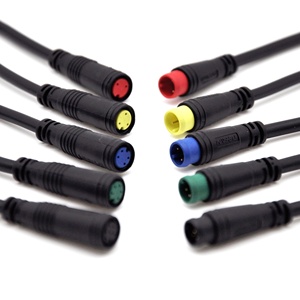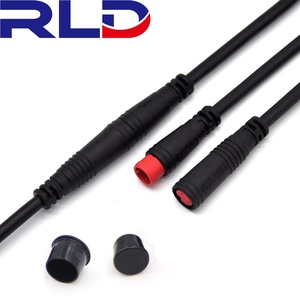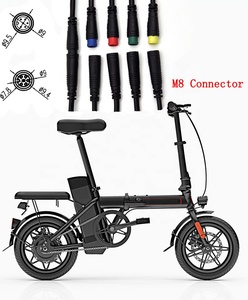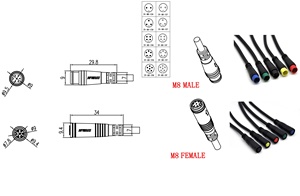
All categories
Featured selections
Trade Assurance
Buyer Central
Help Center
Get the app
Become a supplier

(594 products available)




















Underwater electrical connector comes in different types, with each type specially made to work with given water depth and pressure.
Locking connectors
The locking electrical connector is made to ensure that the connection does not easily get disconnected in the process of operations. These connectors have threaded or ratchet-style locks that secure the connection, thus making it possible to have a secure connection even in rapidly changing environments. Locking connectors are useful for high-vibration or turbulent water settings since they greatly reduce the chances of accidental disconnects.
Ball and socket connectors
A ball and socket connection is widely recognized for the offering of greater flexibility in movement compared to other types. This connector has a spherical ball end which fits into a cupped socket, thus allowing some angular mobility. Such a property makes it possible for the connected equipment to have some degree of motion without putting much stress on the connection. This is advantageous in dynamic underwater environments, which require constant movement or adjustments to affixed equipment.
Fibre optic connectors
These kinds of submersible connectors are meant to mitigate the communication needs underwater by helping an optical cable connect. They are manufactured to restrict the passage of water and ensure the high-speed transfer of data. Fibre optic connectors are normally deployed in situations requiring real-time communication, video transmission, or data transfer across great distances.
Hybrid connectors
As is apparent from their name, hybrid connectors have several types of connections, such as electrical, fluid, and fibre optic, all in one. These connectors are advantageous when operating systems have complicated requirements, as they simplify installations and reduce the need for multiple connections. An example of their application is in remotely operated vehicles (ROVs) that require power, communications, and control signals through one connector.
Pin and sleeve connectors
Pin and sleeve connectors are usually applied for high power situations. These have a cylindrical design with pins and matching grooves (or sleeves) that ensure a firm fit. The submersible trailer connector is designed to distribute power safely and efficiently, where great electrical loads are needed, such as on commercial vessels and aquatic facilities.
Submersible connectors are made to withstand the tough conditions they meet in underwater environments, which require them to be made of very durable materials.
Corrosion-resistant materials
Marine-grade materials like stainless steel and bronze are largely used in building submersible connectors. Stainless steel has a very high resistance to corrosion, which makes it ideal for connecting materials. You will find some connectors manufactured using copper-nickel alloys, which are great at resisting biofouling and galvanic corrosion. Corrosion-resistant materials ensure longevity by eliminating the tendency of parts to degrade and thus wear out over time.
Sealing mechanisms
Submersible Connectors usually have a sealing feature comprising o-rings or elastomeric gaskets made from silicone or nitrile rubber, among other materials. Such sealing mechanisms ensure a watertight seal that blocks water, debris, and air from entering the connector, damaging the items inside the enclosure. These seals have an IP rating of 68, signifying connectors can be submerged in water continually without any adverse effects.
High-strength housing
The housings of submersible connectors are normally constructed with reinforced materials like polycarbonate or glass-filled nylon; in some cases, metal for extreme application. These materials are hard enough to protect the internal components from impact, crushing, and extreme environmental conditions such as high pressure and temperatures.
Electrical conductivity and insulation
Good electrical conductivity materials like copper or gold are normally used for the internal contacts or terminals of the submersible power connector. The insulated materials encasing these conductive parts are made of ceramic or high-performance plastics to avoid electrical leakage and short circuits. These insulators help protect and prolong the connector's lifespan in wet, hostile conditions.
Resistance to biofouling
Submersible connectors are designed with special anti-biofouling surface treatments or materials. Biofouling, aquatic life and microbes clinging on surfaces, can interfere with the functioning of connectors. Anti-biofouling treatments ensure that connectors work well for longer even without being clogged up by organisms that may degrade their functionality.
Submersible connectors are vital across many industries because they operate in wet, underwater settings. Apart from their versatility, they are valued for their durability and functionality.
Value in marine and ROV operations
Submersible connectors are essential in marine industries, such as shipping, oil and gas, and underwater construction. They are fitted onto remotely operated vehicles (ROVs), providing electrical connectivity to enable control, communications, and power to work while underwater. Connectors allow these industries to ensure paid productivity and lower risks. Hence, the global market for RV connectors is worth billions and growing fast.
Aquaculture and underwater farming
With underwater farming systems and aquaculture, submersible connectors power and control sensors, aerators, and monitoring equipment. This makes the systems efficient and minimizes manual work. In the expanding field of underwater agriculture, demand for these connectors will directly impact their commercial value and increase the value they have in sustainable food production systems.
Renewable energy systems
In offshore wind farms and tidal energy systems, the connectors enable electrical and data connections between the turbine and the monitoring systems. This will contribute to the feasibility of offshore renewable energy and more expansion connected to green energy initiatives. As the global demand for renewable energy rises, so will the need for underwater connecting devices, which is good for business.
Increased automation and technology
Underwater robotics, monitoring systems, and IoT devices are being developed and deployed in marine environments. Submersible connectors in these systems help ensure data transmission and power supply critical for their operation. As underwater technologies grow and evolve, the demand for connectors will also increase, increasing their commercial value.
The performance and reliability of the equipment in underwater environments depend on the right aquatic connector.
IP rating or Ingress Protection rating
Check the IP rating of the holder. Select one with a high IP rating that allows submersion. A rating of IP68 means protection against dust and water seepage for long periods. This ensures the connector stays dry and functions perfectly, no matter how deep the water goes or how long it stays submerged.
Material composition
Select a connector manufactured with materials that resist corrosion. Materials such as copper alloys, stainless steel, and titanium provide resistance to galvanic and electrolyte corrosion. This will allow the connector to last longer in marine or freshwater conditions while preventing fraying or signal loss and being submerged with aquatic plants.
Seal types
Submersible connector sealing types are o-rings and gaskets. These provide a watertight seal, thus keeping water and debris out. Go for one with silicone or nitrile rubber seals, as these can withstand extreme temperatures. The combination of a high-grade seal type and water-resistant material guarantees another layer of protection for your connector against fraying and damage.
Mechanical strength
Select a connector with high mechanical strength. The stronger the connector, the less likely it is affected by water pressure, currents, or vibrations. Stronger connectors generally survive longer in harsh underwater settings where equipment is subject to regular movements and extreme environmental elements.
Compatibility with cable
Ensure the submersible connector is compatible with the cable you will be using. This involves matching the connector's size with the cable diameter to produce a snug fit. This eliminates any airspace between them, ensuring the two work together seamlessly in underwater settings. A proper connection reduces signal leakage, short-circuiting, and frayed wires.
The number 6 in IP68 means that the device is totally protected against dust. The number 8 means after testing for continuous water immersion, there would be no entry of water at all. So, IP68 means it's fit for underwater as well as dusty environments.
They are constructed out of corrosion-resistant materials such as stainless steel, copper alloys, and sometimes titanium. These materials ensure long-term durability in both salt and freshwater environments, avoiding signal loss and degradation.
One should select connectors that have a reinforced polycarbonate or metal housing. Such are designed to stand up to extreme pressures, currents, and impacts. Stronger connectors are better suited for dynamic underwater applications, aiding longevity in harsh conditions.
This system transfers power or signals through the air gap separating the two. It eliminates the need for a physical connection, greatly reducing wear and corrosion. They are fitted in remotely operated vehicles and underwater sensors where maintaining a wathtight seal is of utmost importance.
No, they are made from silicone, nitrile, and polycarbonate, which are not biodegradable. They will last long, ensuring no marine creature is harmed by its presence. End-of-life recycling programs are available in many regions to minimize environmental impact.